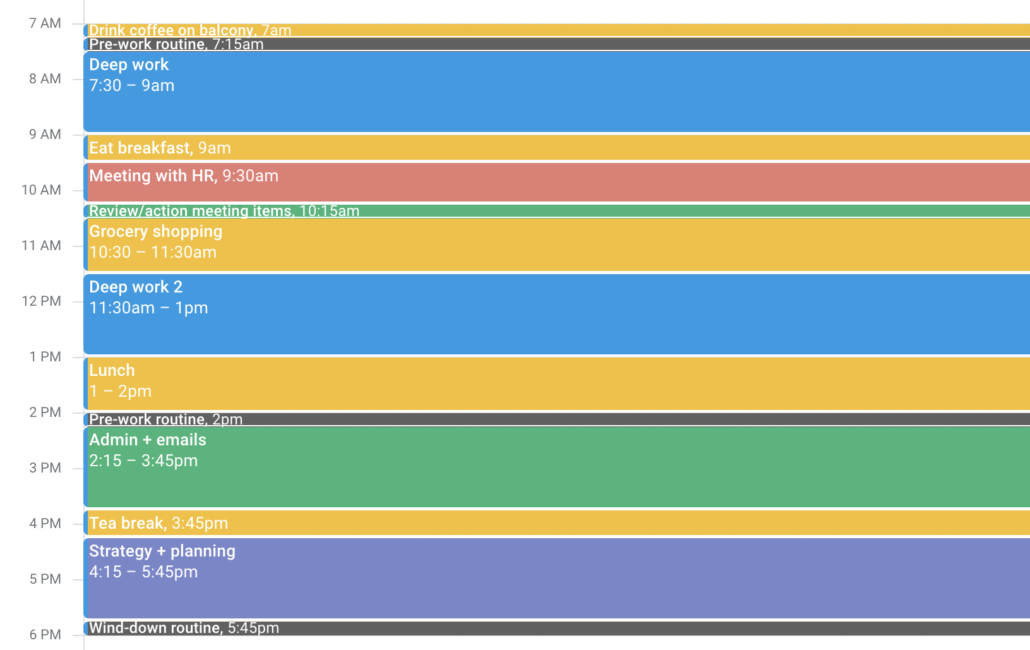3 Ways to Boost Productivity as a Digital Nomad
The digital nomad life is packed with distractions and unpredictability. From being on the road to adjusting to new cultures and getting set up in far-flung destinations, there’s always plenty of attractions vying for our attention.
The key to staying productive and focused as a remote worker lies in knowing how to manage your time and energy for optimal results.
And with that in mind, these three productivity techniques could be just the ticket to help you get more done in less time, from anywhere.
1. Productivity technique 1: Time blocking
What is it?
Developed by productivity guru Cal Newport, time blocking is the practice of dividing your entire day into distinct blocks of time, each dedicated to a specific task or type of work.
By leveraging your available time rather than working off an endless to-do list, time blocking allows you to schedule all your daily tasks based on their category – such as deep work, administrative tasks, and personal time.
Why it works:
Avoids task switching: Task switching can reduce productivity by up to 40%. Time blocking minimises this by grouping related tasks in a single time batch.
Enhances focus: Applying time blocking to create dedicated time slots for tasks reduces distractions and promotes sustained attention.
Reduces decision fatigue: With time blocking, you increase the predictability of your day, which minimises the stress of decision fatigue and boosts cognitive efficiency.
Example of a time-blocked day
The benefit to digital nomads:
By scheduling time for every task you need to achieve in your day, time blocking allows you to achieve your goals in a structured way.
Time blocking is a particularly handy productivity tool for digital nomads; factoring in time for both work and personal activities (such as exploring and socialising) can help you to create more balance and reduce the risk of remote burnout.
How to implement time blocking
2. Productivity technique 2: Energy syncing
What is it?
Energy syncing for productivity is the process of aligning your schedule with your natural energy peaks and troughs throughout the day. Rather than managing time alone, you manage your energy levels.
For example, many people experience higher levels of focus in the morning, making this time of day more suited to deep work or more cognitively challenging activities. Meanwhile, the afternoons might be best allocated to simpler admin tasks.
Why it works:
Optimizes peak performance: By aligning your most demanding tasks with the times of day when your energy is highest, you maximise focus and efficiency, making it easier to tackle challenging work without feeling drained.
Reduces risk of burnout: Managing energy instead of just time allows for more balanced workdays, incorporating breaks and downtime when energy dips. This reduces the risk of overworking and helps maintain long-term productivity,
Adapts to lifestyle changes: Unlike rigid time-based systems, energy management is flexible and can be adapted to your changing environment and routine.
The benefit to digital nomads:
By reducing the risk of burnout and overwork, energy syncing can be especially beneficial for digital nomads balancing work and travel.
What’s more, its flexible nature makes it well-suited to remote workers whose schedules may shift due to travel or time zone differences.
While energy syncing is particularly beneficial to nomads who are able to set their own schedule, everyone can leverage the principles of energy syncing by identifying their daily rhythms and scheduling tasks accordingly.
How to implement energy syncing
3. The two-minute rule
What is it?
The two-minute rule is a productivity technique proposed by productivity expert David Allen, which states that:
“If a task can be completed in two minutes or less, do it immediately”.
While it may sound deceptively simple, the two-minute rule is a great way to keep small tasks from piling up and becoming distractions later in the day.
Why it works:
Avoids procrastination: Small tasks are easy to put off; by handling them immediately, the two-minute rule prevents procrastination, keeping your to-do list clear of minor distractions.
Creates momentum: Completing quick tasks gives you a sense of accomplishment and builds momentum, making it easier to tackle larger tasks with confidence and focus.
Reduces cogntive load: By handling tasks right away, you avoid mental clutter and the cognitive load of remembering to come back to them later, allowing you to stay focused on more significant projects.
The benefit to digital nomads:
By maximising efficiency on the go, the two-minute rule can be useful for the distraction-filled digital nomad life. By quickly knocking out small tasks, you free up time for focused work, even in unpredictable settings.
It can also help reduce task backlog during travel, allowing you to stay on top of small tasks and make the most of ‘transit downtime’, such as waiting for transportation.
How to implement the two-minute rule
Want exclusive access to all our resources, templates, and tools for digital nomads and remote workers?




